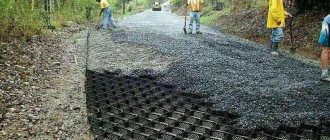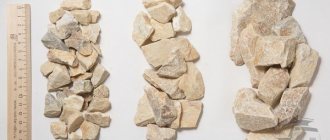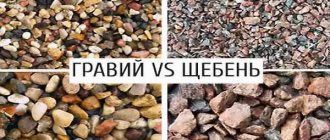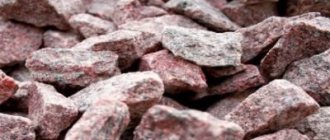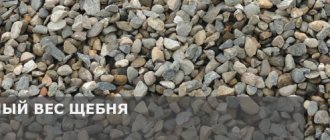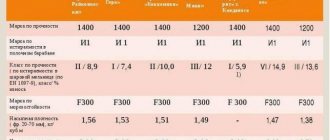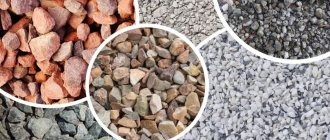In this article we will look at 3 main types of crushed stone for the construction of secondary roads in villages, SNT and cottage communities.
If you are faced with the task of tidying up the local area, improving the quality of roads in a dacha community, or temporarily organizing a road during the construction of new residential buildings, pay attention to the following types of crushed stone: limestone, asphalt, recycled.
They are suitable for this category of work and allow you to get a good quality road surface for little money. But the task of saving money during the construction of non-main roads and in summer cottages is a priority.
Types of crushed stone for roads
Recycled crushed stone
Recycled (concrete) crushed stone is obtained by processing concrete slabs, blocks, and debris of buildings and structures. This is one of the most popular types of crushed stone for the construction of parking lots and roads.
The advantages of recycled crushed stone include:
- Low price - about 2 times lower than for limestone crushed stone. In the case of recycled crushed stone, we are dealing with a processed product, not a natural extraction product. Considering the volume of new construction in Moscow and the region, and, accordingly, the volume of demolition of old buildings, there are no problems with the supply and processing of concrete slabs. — direct producer of secondary crushed stone. At any time, you can order the volume of crushed stone you need and be confident in the prompt delivery of quality material first-hand.
- Versatility - recycled crushed stone is used not only as a finishing coating, but also as a base on which asphalt or asphalt chips are laid. It is not afraid of moisture and is compacted well with a roller or vibrating plate. If desired, a road made of recycled crushed stone can be covered with the same asphalt chips on top to compensate for its not the most presentable appearance.
A few words about the disadvantages of recycled crushed stone:
- The presence of impurities - brick, metal, wood. As a result of the demolition of buildings and the subsequent recycling of concrete slabs, metal, brick or wood impurities sometimes get into the secondary crushed stone. Metal in secondary crushed stone is removed in production using magnetic plates, but this type of crushed stone still cannot be called 100% pure. And the customer must be ready for this.
- Less aesthetic. Unlike crushed limestone, the secondary one does not look very presentable. It is unlikely to be suitable for the design of local areas, but for local roads in villages and SNT, for parking lots and parking lots it is excellent. Recycled crushed stone can withstand the weight of a passenger car, and uneven color and lack of aesthetics can be compensated for by covering the crushed stone on top with asphalt chips.
The price for recycled crushed stone in Moscow is from 400 rubles per ton.
Photos of roads made of recycled crushed stone
Technology of laying asphalt on crushed stone-sand mixture
The provisions of State Standards define the technology for laying any types of asphalt: hot, cold, cast, liquid. Exactly the same requirements apply to the procedure for performing pothole repairs.
- When performing pothole repairs, cast asphalt can be laid at sub-zero temperatures, but the base must be heated to ensure the best adhesion of the asphalt concrete to the internal surfaces of a crack or pothole.
- Asphalt mixtures are laid out on a specially prepared base. The crushed stone-sand layer is carefully compacted and primed with bitumen emulsions. Hot asphalt is laid immediately upon delivery, making sure that the temperature of the mixture does not drop below 130 degrees.
- When working with cold asphalt, dry the treated area and remove debris, dirt and dust. All internal surfaces of the road defect are primed with bitumen emulsion.
- The mixture is laid using special equipment, leveled and compacted using rollers, an asphalt paver or vibropress.
The final compaction of areas with cold asphalt is carried out during the movement of vehicles.
Asphalt crushed stone
Crushed asphalt is obtained by crushing asphalt chips and further dividing it into fractions. This is a relatively new building material, which is already in great demand due to its low price and the presence of bitumen in the composition. Crushed asphalt is extremely resistant to moisture and frost, and its characteristics are similar to ordinary asphalt.
Advantages of crushed asphalt:
- Cleaner than secondary. The production of crushed asphalt is similar to secondary, but the fundamental difference is in the feedstock. If the secondary one is made from concrete slabs, where brick, wood, and metal come across, then the asphalt one is made from asphalt chips. Therefore, it is uniform in composition and color and has no impurities.
- Does not require topcoat. Crushed asphalt, over time, under the influence of the sun and car wheels, is compacted very well without the help of special equipment. The bitumen in the composition guarantees a smooth road surface that does not require a finishing layer.
Among the disadvantages of crushed asphalt, we can only remember the characteristic smell of asphalt in the heat. This is not critical for roadways, but is inconvenient for use in local areas.
The price for asphalt crushed stone in Moscow is from 450 rubles per ton.
Photos of crushed asphalt roads
The advantage of asphalt paths
Speaking about asphalt, I would immediately like to say that this building material has more disadvantages than advantages in relation to a summer cottage.
Asphalting of a summer cottage
Asphalt pavement has only a few main advantages - low cost, high strength, simple creation technology and versatility. Often asphalt is chosen only because it has the lowest price compared to materials for paving garden paths such as paving slabs, paving stones, decking, natural stone, etc.
The disadvantages of asphalt are very significant factors that affect not only the landscape design of the garden plot. Among the most significant disadvantages are:
- In hot weather, asphalt evaporates and exposes the human body to harmful substances. In addition, the unpleasant smell itself will not allow you to have a rich rest in the garden, which is what we need.
- Asphalt coating has practically no decorative ability, so it is not only not suitable for decorating a site, but on the contrary, it will worsen the situation. Asphalt paths practically do not fit into garden styles, which is also very bad. The only exception is colored asphalt, to which various pigments are added, so that the coating can be not only the usual gray color, but also green, pink, blue, etc.
- If laid poorly, asphalt quickly deteriorates in winter: water gets into the cracks, freezes, and when it freezes, it destroys the coating.
- During the heat, the asphalt melts.
As you can see, the disadvantages of asphalt pavement are more significant than the advantages, but despite this, it is recommended to build asphalt paths at functional nodes of the garden: for example, between the garage and the utility block. It is strictly prohibited to build asphalt paths near recreation areas. due to the harmfulness of asphalt.
Limestone crushed stone
Limestone crushed stone is a natural crushed stone mined in quarries in the Tula, Kaluga and Vladimir regions. It is a sedimentary rock of relatively high strength (M600), has a light gray tint and a uniform shape.
It is used for the construction of rural roads and in the construction of large highways as a base for laying asphalt. Great for walking paths and garden paths.
The advantages of this type of crushed stone include:
- strength;
- environmental friendliness;
- aesthetic appearance;
- self-sufficiency - limestone crushed stone does not always require a finishing coating. For example, crushed limestone is sufficient for filling parking lots and organizing beautiful, neat garden paths. There is no need to complete its installation with an additional top layer.
This crushed stone also has a couple of disadvantages.
- It does not like water - therefore it is not used on swampy soils and soils, and also requires a well-designed drainage system.
- It costs more than recycled and asphalt crushed stone. Due to the fact that crushed limestone is mined not in Moscow, but in neighboring regions, its price directly depends on the remoteness of the quarry and the cost of transportation. In addition, interruptions in the supply of certain fractions of crushed limestone are occasionally possible, but the wait for a batch usually does not exceed 7-14 days.
The price for crushed limestone in Moscow is from 1036 rubles per ton.
Photos of crushed limestone roads
Preparing the place
First you need to decide on the boundaries of the tracks or site. Knowing the area will allow you to subsequently calculate the amount of asphalt concrete mixture, crushed stone, sand, and also order a curb stone (if you want high sides of the fence) or a curb for the paths.
- We remove the layer of earth. It is necessary to take into account that the greater the load on the asphalt concrete pavement, the greater the depth of the “trough”. Experts advise removing at least 30 cm. When making a recess, you need to remove the roots of trees growing nearby, because as they grow, they increase in size and can destroy the coating.
- Installing a side stone or curb around the perimeter, which will mark the boundaries of the site or path, will stop the spreading of the covering, and also serve a decorative function. For installation, you need to dig a trench slightly wider than the curbs. We pour a cement solution into the trench and install a side stone on it. Want to avoid uneven borders? Stretch the twine on both sides of the path.
- Making a pillow. The bottom of the recess (trough) must be compacted carefully so that during operation it does not shrink, which can lead to destruction of the coating. Now you need to fill in a 15-centimeter layer of coarse-grained crushed stone and compact it. The next layer is fine crushed stone up to 10 cm thick. We compact it again. The last layer is sand. Its thickness is from 5 cm. The pillow is filled with water, and after that the base needs to be rolled (compacted).
- Creation of drainage. To prevent water from stagnating on the new path, when laying the asphalt pavement, you need to make a slight slope of up to 20, and also make small outlets that will direct the water flow into the ground.
- Laying asphalt concrete mixture. The main rule when laying is to observe the temperature regime of the mixture. Cold asphalt will not compact well and will quickly collapse. Therefore, it is better to order asphalt concrete mixture, ready for laying, from the manufacturer. It will be delivered quickly, and the desired temperature will be maintained. Now you need to evenly scatter the asphalt over a section of the path (or the whole) and level it with a mop. Where there are depressions, you need to fill them up, and where there are bumps, you need to smooth them out. Please note that the thickness of the asphalt concrete pavement must be at least 5 cm to ensure sufficient strength of the surface of the site or path. All work must be carried out as quickly as possible in order to maintain the temperature of the coating. Now you need to roll the covered section with a roller. To prevent the mixture from sticking to the roller drum, it is pre-lubricated with diesel fuel (diesel fuel), the same can be done with shovels.
The roller is used only in a straight direction (it is not possible to go backwards). The seams are rolled across. If the weight of the roller is small, you need to ask someone to stand on its frame. Do not leave the skating rink on a freshly laid track.
If you have any doubts about preparing the base or laying asphalt, contact a specialist. Everything will be done quickly, and the cost of the work is quite affordable.
Choosing crushed stone fraction for the road
Before starting road work, decide on the fraction (size) of crushed stone. For roads, three fractions are usually used: 20-40, 40-70 and 5-20.
- Fr. 20-40. Suitable for repairing old roads, provided the base is partially prepared and the top layer of soil has been removed. This fraction does not go into the ground, it requires minimal road preparation, but to prevent the 20-40 grains from spreading under the wheels of cars, you will need asphalt chips for the finishing coating.
- Fr. 40-70. The second most popular faction for roads. It is used if there is no base, the cushion has not been prepared, and the top layer of soil has not been removed. It is used in wetlands and if special equipment is planned to travel along the road. You should always remember that the 40-70 fraction is large, it is difficult for a passenger car to drive through it, and it is inconvenient for riding bicycles and walking. This fraction does not go deep into the ground; large stones can interfere with the comfortable movement of a person, so it is better to cover it on top with asphalt chips or small crushed stone.
- Fr. 5-20. Typically not used for road construction due to the grain size being too fine. Fraction 5-20 quickly goes into the ground, spreads and gets stuck in the wheels of cars. More suitable for the design of indoor areas: filling garden paths and zoning areas.
Bottom line: if you have the financial means and want to make a reliable and aesthetically pleasing road, choose crushed limestone. If price and quality are primary for you, and appearance does not play a special role, use recycled or asphalt crushed stone - this way you will get a high-quality road at a minimal price.
Find out more about all types of crushed stone here: https://eko-crushed stone.rf/shcheben
Answers to frequently asked questions:
Is it possible to lay asphalt over asphalt chips?
Yes, asphalt crumbs are suitable for forming a road cushion, but they must first be thoroughly crushed to medium-sized fractions. The layers are impregnated with bitumen emulsion for better adhesion. Asphalt crumbs are suitable for creating the base of a temporary road or yard in the country. Asphalt crumbs have a shorter service life than other raw materials.
Is it possible to lay asphalt on sand?
Sand is well suited for forming a road cushion, but only together with crushed stone. Fine sand fractions are not suitable for the base layer, as the road may settle under vehicle load. Sand is used as the top layer of the base.
To form a good and elastic cushion, a sand-crushed stone mixture of different fractions is suitable. Large crushed stone is placed down for drainage.
When forming a pillow, it is necessary to make slopes to allow water to drain. The slopes are placed at a distance of 1 meter from each other.
What determines the cost of crushed stone?
The cost of crushed stone for road construction is an important factor that determines the choice of material when drawing up estimates. Pricing depends on the following factors:
- volumes of material supply,
- the distance to which delivery is required,
- type of crushed stone and fractional characteristics.
When ordering a batch of building crushed stone, it is recommended to pay attention to such points as strength, abrasion resistance, radioactivity, resistance to temperature changes, shape and appearance. For the construction of highways, moisture resistance and filling density are considered important factors. By purchasing material that meets the requirements of GOST, you guarantee high quality of the road surface, traffic safety and long service life, reduced costs for binding materials without loss of functional characteristics. Choose the building material correctly - this will save on additional costs and significantly extend the period between repairs.
